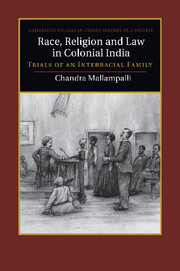Book contents
5 - The Path to Litigation
Published online by Cambridge University Press: 05 December 2011
Summary
Ever since Matthew’s stroke in 1836, the Abrahams may be viewed as treading along a path to litigation. The family’s rise to economic and social prominence was rapid and unpredictable. Immediate demands of the business consumed them more than plans for the distant future. Matthew’s thriving and diverse portfolio – with investments in liquor, real estate, cotton, wax, saltpeter, and many other commodities – grew over three decades to be worth more than 300,000 rupees. Never had his father known such wealth, perhaps not even among those he had served as a dressing boy or mess butler. Neither had Charlotte’s side of the family enjoyed any degree of affluence. Amid the multiplication of stresses and perks that accompanied their entry into this new terrain, they devoted little thought to questions about succession. Whether from denial or inexperience, they were ill-prepared for Matthew’s demise.
Who would succeed the Pedda Dora? Francis’s words, “there was no will,” signified a much larger void, and the steadily chilling relationship between Charlotte and Francis concerned more than a contest for authority between two personalities. Both reflect the family’s lack of any coherent script or story line about itself, which would allow the family to perpetuate its wealth and identity. Going to court compelled Charlotte and Francis to produce narratives that would break this silence, bring their complex family under one cultural rubric, and steer them under one head.
- Type
- Chapter
- Information
- Race, Religion and Law in Colonial IndiaTrials of an Interracial Family, pp. 129 - 148Publisher: Cambridge University PressPrint publication year: 2011



